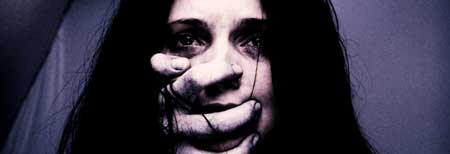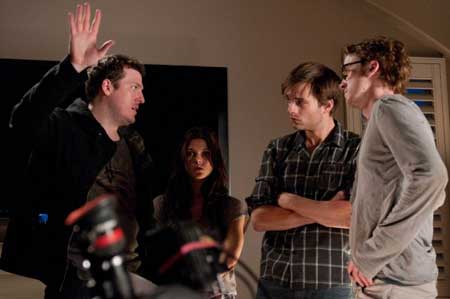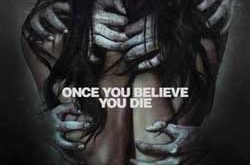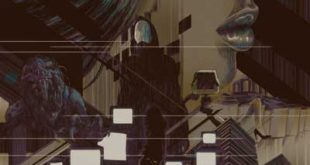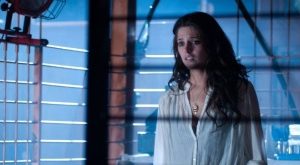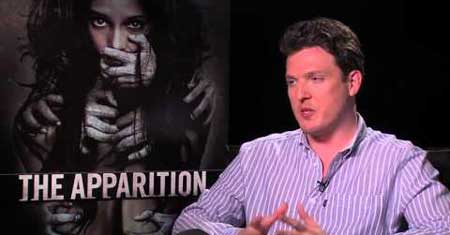 Todd Lincoln is something of a “Jack Of All Trades” judging from his bio. He’s contributed to various films as a cinematographer, editor, writer, producer & visual effects technician, but his main focus has always been on writing and directing. Now his first feature film as a director (After directing a slew of shorts), “The Apparition”, has just been released and he is eager for it to make it’s mark on the horror genre. Despite his busy schedule he found some time to sit and talk with Horrornews.net about the film and what he has planned for the future.
Todd Lincoln is something of a “Jack Of All Trades” judging from his bio. He’s contributed to various films as a cinematographer, editor, writer, producer & visual effects technician, but his main focus has always been on writing and directing. Now his first feature film as a director (After directing a slew of shorts), “The Apparition”, has just been released and he is eager for it to make it’s mark on the horror genre. Despite his busy schedule he found some time to sit and talk with Horrornews.net about the film and what he has planned for the future.
HN: First of all congratulations on directing “The Apparition” your first feature film!
TL: (Laughing) Thank you! Thank you very much!
HN: You’ve done a few short films before moving on to this one. Besides the obvious budgetary differences, What did you find to be the biggest difference between directing short films and feature films?
TL: Well it took a lot longer! I came from directing, editing, writing & producing all of those short films and in between all of that I learned the music video/commercial ropes as well. The dream and the plan was always to move on to directing features and all of that experience combined to help get me more than ready to direct a feature length film. Over the past several years I developed projects as a writer/director at Fox-Searchlight, Universal and a couple of other places. I’ve spent 2-3 years developing projects only to see them get stuck in development hell. A couple of those projects came very close to being made, they were cast and locations had been scouted but for whatever reason they’d get right up to the starting line only to fall short. So “The Apparition” was the first one that actually made it all the way through. The whole project came together very quickly, going in to pitch it to Warner Bros. and Joe Silver who greenlit it quickly.
I think the big difference between the two for me is trying to keep all of the details straight in my head. Overseeing all of the different departments who are very much in the mode of “We’ve done all of this before, all of these other horror films” so I wanted to keep them as honest and authentic as possible. A lot of departments will reach for their “Go To” package of stuff and that could be the location scout, production designer, art director…whoever. For me it was important to come from a fresh and honest place and try to move the horror genre a little bit further. Trying to get people away from some of these lazy ways of thinking, these bad habits they’ve fallen into on so many other films and get the horror genre out of the “Go To” horror world where you see stories take place in small town USA with the sheriff and deputy on main street or in the old rusty basement. You also have to shoot out of order when you make a feature and you have to build suspense and scares at the same time. It’s tracking the emotional content, the horror content that’s harder to do on a feature than on a short. It’s just a much bigger balancing act in which you have to stay on top of everything and you’re working all areas of your brain at the same time. Another big difference between the two is you’re getting almost no sleep while making a feature and you always end up running on your love of movies and Adrenaline, nothing more.
There are so many filming differences between the two but I suppose you can look at each scene in a feature film as a short film in a way but not really because it’s connected to this bigger picture…this bigger theme, and you’re just having to track many things as you’re trying to take an audience on this ride you’ve concocted. This was a good question!
HN: Thanks! Now could you tell us what “The Apparition” is about?
TL: It’s about a group of university parapsychology students who set out to “Create” a ghost in an experiment, and they eventually end up getting something! Then we see how it affects them and a young couple played by Ashley Greene and Sebastian Stan who’ve recently moved into her mom’s rental home which is located in a isolated suburban area. This experiment of creating a ghost is inspired by a real experiment that I came across while researching some paranormal phenomenon websites. Back in the 70’s something called “The Philip Experiment” took place in which a group of psychology students set out to create a ghost who they subsequently named “Philip”. He was a fictional character who they focused on and tried to believe in and sometimes there would be a knock on a table they set up or a scary sound coming from one side of the room and as this presence got more aggressive they got terrified and halted the experiment but in following decades other people have attempted the same experiment and had much better equipment so everything was amped up. I thought this was a fascinating idea for a horror film, this idea of “Creating a Ghost”. The house is the main location in the film but we go to various locations throughout. The house is not the source of the haunting in this film…it’s the people, the experiment and if there is a ghost in this movie it’s not a ghost in the traditional sense. In the paranormal field this is the rarest and most terrifying thing they could come across, this idea of finding a full body apparition. This is not the apparition of a human or anything that was ever living, this is a dark, malevolent, unknown, inhuman entity that gets it’s power from belief and fear. I thought that was fascinating to explore and I brought on a paranormal investigator named Joshua P. Warren as a consultant and he actually has attempted this kind of experiment to create a ghost and has actually began to get some concrete results. I was inspired by these experiments and Joshua was inspired by some of the ideas I had for the film and he’s actually started to really get stuff with the EEG headsets that monitor your brain activity and your belief that are hooked up to these military grade amplifiers. So instead of say four people sitting at a table trying to believe in something these headsets and amplifiers can make it seem like it’s 4000 people trying to believe in something, and when you have that many people believing at once it can make strange and scary things start to happen.
So I tried to make a film that movie fans, horror fans, fans of the paranormal and paranormal investigations would all look at and understand that we were trying to come from a place as authentic and honest a place as possible and not just do this sort of “Go To” horror movie stuff. It’s more of a film about what you don’t see and what we don’t show or explain but then at a certain point the film does ramp up in kind of a “Poltergeist” way and it becomes more of a ride that goes to some crazy places where you’re gonna see some crazy things! The film is very much about this couple in transition and sort of american transition and we’re really very honestly capturing the contemporary settings of the suburban sprawl & the big box stores, these corporate franchises and restaurants. These foreclosed homes and all of these houses standing empty and trying to show some locations that we have to drive by everyday, I think that always helps when the horror moments arrive. If the whole movie just lived in some “Horror Bubble” in which the characters went to a grocery store or a dry cleaner and somebody had to add cobwebs or dust and scratches all over it would just feel wrong. I think it’s better to treat it as real life so that the horror moments have more weight.
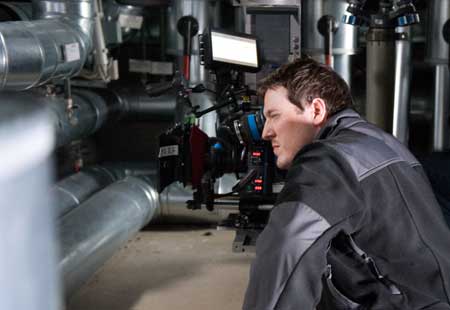 HN: Do you consider your film a “Slow Burn” kind of movie or is it more of an “Thrill Ride” kind of film?
HN: Do you consider your film a “Slow Burn” kind of movie or is it more of an “Thrill Ride” kind of film?
TL: It has a very interesting look and feel, I’m still trying to figure out how to describe it actually! I think some of the key references you can make is it’s part “Poltergeist”, part “Flatliners”, part “The Strangers” with touches of “The Twilight Zone” and “Night Gallery” episodes tossed into the mix. We learned great lessons from “The Haunting” & “The Innocents” and we let things breathe and build just as in those films. My favorite decade for horror films was the 70’s where films were more slow burn than thrill ride. They were more about what you didn’t see…which made the films far more effective.
We’re sort of pushing different buttons and it’s kind of a “Everything Must Go” fire sale/horror blowout! We’re trying to burn the forest for a regrowth of a new decade of horror.
HN: It’s funny that you mentioned “Flatliners” because that’s what came to my mind when you described what the film was about…
TL: The way the cast fell into place reminded me of when “Flatliners” was being made and they cast the new, fresh faces of Hollywood. “Flatliners” is not a favorite of mine but I did draw some parallels to it as the film progressed. I know Ashley Greene was especially terrified of the script and she responded to the character and the concept, we shared the same appreciation of small details of life. Tom Felton, who plays Patrick in the film was like me, a fan of the paranormal and he was dying to do this movie. Sebastian Stan just found it to be the right script at the right time for him. It just sort of fell into place organically and naturally. They all brought a great intensity to the film.
I really want audiences to know that I was fighting the good fight for them! This isn’t a remake or a reboot, not a sequel or an adaptation. It’s not a found footage film or another micro budget film. It’s not shot on digital, it was shot in 35 MM in 2:35 aspect ratio with these great vintage anamorphic lenses that we tracked down and we’re coming at this honestly and passionately!
HN: Do you really believe in ghosts?
TL: Yes. Although I think there are so many various unknown phenomena… that we mistakenly label as ghosts / apparitions… when they are something else entirely
HN: Were there any mishaps or odd occurrences that took place during production?
TL: Not really. But there was definitely a dark heavy feel surrounding the shoot that helped keep the crew and actors in the right mindset.
 HN: Your film is rated PG-13. Do you think horror films with that rating can be as effective as “R” rated horror films in this day and age when audiences might be jaded?
HN: Your film is rated PG-13. Do you think horror films with that rating can be as effective as “R” rated horror films in this day and age when audiences might be jaded?
TL: PG-13 horror films can absolutely be as effective as an R-rated horror films. Sometimes even more effective. Some PG or PG-13 horror films include POLTERGEIST, JAWS, INVASION OF THE BODY SNATCHERS (1978), SIXTH SENSE, THE RING, THE GRUDGE, THE OTHERS, GREMLINS, SALEM’S LOT, FIRE IN THE SKY, CLOVERFIELD, THE LAST EXORCISM, ROBERT’S WISE’S THE HAUNTING, THE INNOCENTS, episodes of TWILIGHT ZONE and NIGHT GALLERY, etc., etc. There are tons of examples out there. Plus, many of people’s favorite horror films from previous decades would be rated PG-13 by today’s standards. All of my past feature projects I’ve developed have been Hard-R. My new upcoming feature projects are being developed as Hard-R. But I pitched, planned and wrote THE APPARITION as PG-13 from the very start. There was no reason for it to be R-rated. I own, watch and love the most hardcore films ever, but I don’t have to go around constantly proving it. Just because you watch “Cannibal Holocaust” or “Aftermath” every day doesn’t make you automatically a true horror fan. There’s room for all types of horror. You have to do what’s right for each film and story.
HN: You wrote a script for the upcoming “Hack/Slash” feature. Is that script going to be the final shooting script?
TL: I spent 3 1/2 years as writer/director developing “Hack/Slash” at Rogue/Universal. We were going to do this right and stay true the concept, heart and spirit of the comic book. Audiences were going to get the Cassie and Vlad that they know and love as well as original terrifying slashers. This was going to be an ultra-cinematic, hard-hitting, terrifying, gore-soaked thrill-ride. We had a great draft that we were getting ready to go shoot and then out of the blue the company Relativity bought Rogue and everything stopped there. At the time Relativity didn’t really understand “Hack/Slash” or know what they wanted to do with it. So I moved on to new projects. The new Rogue/Relativity execs have since brought on a few other writers and attached a couple of different directors to do all new takes, but I don’t believe the project is currently active or moving forward. Whatever script they have most likely wouldn’t contain many elements from my original script or my vision for the film. I’m still a huge Hack/Slash fan and am good friends with Tim Seeley the creator/writer of the comic.
HN: Do you want to continue making films in the horror genre?
TL: Oh most definitely! The horror genre is my favorite genre, I’ve always been into this and always been around it and I have so many stories I want to tell. All of my previous projects were hard “R” horror films and as a matter of fact I hope my next project is going to be an adaptation of “The Nye Incidents” which is a graphic novel written by Whitley Streiber and it’s a terrifying take on alien abductions and mutilations. We’re looking at actresses now and putting together a package for investors. And I’m also adapting a short story called “Twittering From The Circus Of The Dead” which was written by Joe Hill who’s Stephen King’s son and an outstanding author in his own right. It’s set up at Mandolay Pictures right now and that one could go pretty quickly as well. I’m interested in all genres and styles and I think filmmakers have to work all of their different muscles and each one helps the other. I ran a film festival (Tulsa Underground Film Festival) for ten years and have seen thousands upon thousands of short films in all kinds of different genres, I processed them all and I am most certainly in it for the long run!
Interview: Todd Lincoln – Director (The Apparition)
 Horror News | HNN Official Site | Horror Movies,Trailers, Reviews
Horror News | HNN Official Site | Horror Movies,Trailers, Reviews
